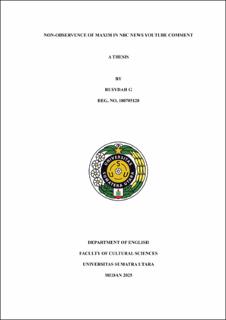| dc.description.abstract | This study investigates the non-observance of Grice’s conversational maxims in the comment sections of NBC News YouTube videos reporting on the Los Angeles wildfires. The analysis focuses on five selected videos, identifying 48 instances of non-observances. Using Creswell’s qualitative analytical framework, the comments were thematically analyzed to identify patterns in how users deviate from cooperative principles in digital communication. The findings reveal that flouting of the maxim of relevance is the most dominant, representing (50%) of all cases, as commenters often shift the topic to express indirect criticism, political discontent, or sarcasm. Flouting of quality and manner maxims appears in (17%) of the data, with users presenting exaggerated, ambiguous, or unsubstantiated remarks to convey distrust or emotional responses. The flouting of the maxim of quantity is the least common, comprising (6.25%), where comments include either excessive personal details or insufficient information. Regarding violations, (8.33%) of comments breach the maxim of quality through unsupported accusations or conspiracy theories, while (2.08%) violate the maxim of quantity by offering vague or overly broad statements. The analysis of implicature characteristics shows that calculability is the most prominent feature. In 43 instances, commenters rely on readers’ ability to infer hidden meanings from indirect or ironic remarks. Non-detachability appears in only one example, suggesting that the implicature depends more on content than wording. Indeterminacy is rare, with only two cases where the implied meaning remains open to multiple interpretations. No examples of cancellability or non-conventionality were identified, indicating that the implicatures tend to be deliberate, context-specific, and resistant to retraction. These findings highlight how users on social media platforms like YouTube employ non-observance of conversational maxims and pragmatic implicature strategies to express opinions, challenge official narratives, and engage critically with crisis-related content. | en_US |


